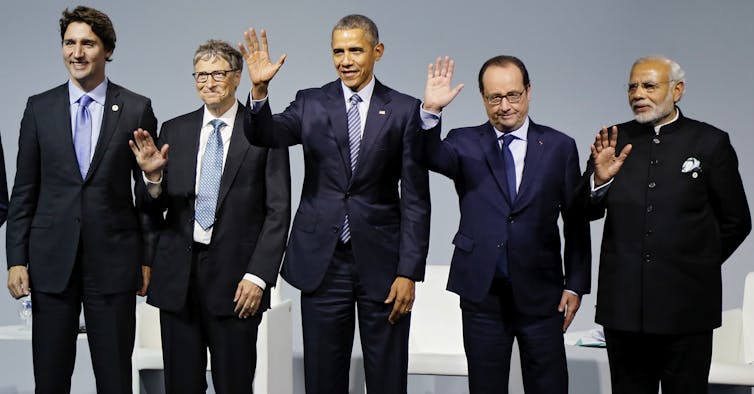In the late 1960s a good chunk of the world’s brightest minds and fanciest labs were devoted to one thing: space exploration. When NASA’s funding peaked in 1966 the organisation employed 400,000 people and consumed more than 4% of the US federal budget. Three years later, after less than a decade of serious investment, man was on the moon.
These days NASA spending makes up just 0.5% of the same budget. Scientists who once would have designed rockets or tested spacesuits have largely moved into the private sector.
The space race might be a thing of the past, but the basic economic model still makes sense: massive, targeted investment in research & development remains the best way to make startling technical leaps forward and solve mankind’s greatest challenges.
The Paris climate talks have so far seen two major pledges to this end. A group of 20 major countries – representing 75% of the world’s emissions – have promised to double their clean energy research over five years. To complement this, Bill Gates has announced a coalition of top business figures committed to achieving a low carbon economy through investing “patient capital” in these new technologies. This follows calls earlier this year for a Global Apollo Programme to address climate change.

In absolute terms, there is lots of money involved. However, total R&D makes up just 3.6% of the US budget in 2015, and spending on renewable energy makes up less than 4% of that. That’s a little more than US$5 billion out of the total US$134.2 billion R&D expenditure. Compared to the effort and outlay to put a man on the moon, this is orders of magnitude smaller.
But the problem today is much bigger. Governments must be more proactive and, in line with recent research, we should use public money to direct millions of scientists and engineers towards solar power, electric transport or better batteries. It won’t deliver a “man on the moon” moment, but this investment is the only way to truly end our dependence on fossil fuels.
This is recognised and addressed in part by “Mission Innovation”, but in order to understand why this is still not enough, it is helpful to understand recent advances in our understanding of the economics of innovation.
Green won’t come out of the blue
Many influential economists such as Yale’s William Nordhaus or Harvard’s Gregory Mankiw, want to fight climate change with a carbon tax. The problem is taxes do a better job of preventing bad things than encouraging better replacements.
Standard economics simply considers greenhouse gas emissions as an “externality” – an economic consequence experienced by a party who did not choose to incur it. Negative side effects such as pollution can be addressed by putting a price on them and forcing those responsible to pay – if your factory produces emissions, it’ll cost you. This is the idea behind carbon taxes. It is assumed that, by making polluting technologies relatively more expensive, the market will adjust, generating low-carbon innovations.
But innovation isn’t as simple as this. In particular, the development and spread of new technologies depends on what has gone before and you can’t simply expect a jump into renewable energy, for instance, when everything is geared towards fossil fuels. This idea of “path dependence” is fundamental to understanding technological change.

Inventors tend to build on existing knowledge, and infrastructure already in place means new technologies often incur high switching costs – just think of the advantage regular vehicles have over electric ones thanks to pre-existing petrol stations. And since the telephone is worthless unless you have someone to call, the value of a new technology may also depend on the number of people who use it. This is what economists call the “network effect”.
Carbon lock-in
All this momentum pushes us to continue with dirty technologies. Even a relatively high carbon tax may lead to firms seeking to make products and processes more efficient, rather than the riskier and more expensive process of changing things entirely. Take cars, for instance. Thanks to various environmental regulations you can now buy a vehicle that does more than 90 miles per gallon – but the big carmakers still haven’t truly embraced electric.
This sort of efficiency improvement may reduce emissions in the short run but eventually there are no more incremental gains to be had and further decarbonisation will require completely new technologies. These technologies will then be even more expensive, with path dependence even more deeply ingrained. This is carbon lock-in.
Carbon lock-in is one of the key insights of recent work in “directed technical change” by MIT economist Daron Acemoglu and colleagues. They find the most cost-effective way to address climate change is early action on both fronts: pricing carbon and supporting low-carbon innovation. Acemoglu and co differ from traditional economic models of climate change by properly considering how new technology emerges, instead of treating it as an “exogenous” process that suddenly arrives like manna from heaven.
Early policy intervention is crucial. It can change the path of innovation from “dirty” (carbon-intensive) to “clean” (low-carbon) and then once clean innovation gains a sufficient advantage it can be left alone, as profit-maximising firms will pursue clean innovation in their own interests.
This is a job for states
If markets left to themselves will continue to merely pump out “innovations” along certain pathways, then it is up to the state to play a more direct role in starting a “greentech” revolution. Mariana Mazzucato, in her book The Entrepreneurial State, argues that major advances in tech from the internet to nanotechnology to pharmaceuticals were born either directly from government research or because governments made the risky investments necessary for the private sector to act.
The good news is that not all money is the same, and those behind Mission Innovation and the Breakthrough Energy Coalition seem to have read Mazzucato. They explicitly reference “patient capital” which can reduce the risk of uncertain technological investments. There is no question this is a major step in the right direction.
Governments certainly need to price carbon, but they should also act as entrepreneurs and market-creators to kickstart innovation for the green growth of the future. If we are underspending on this by orders of magnitude, then doubling is not nearly enough.

